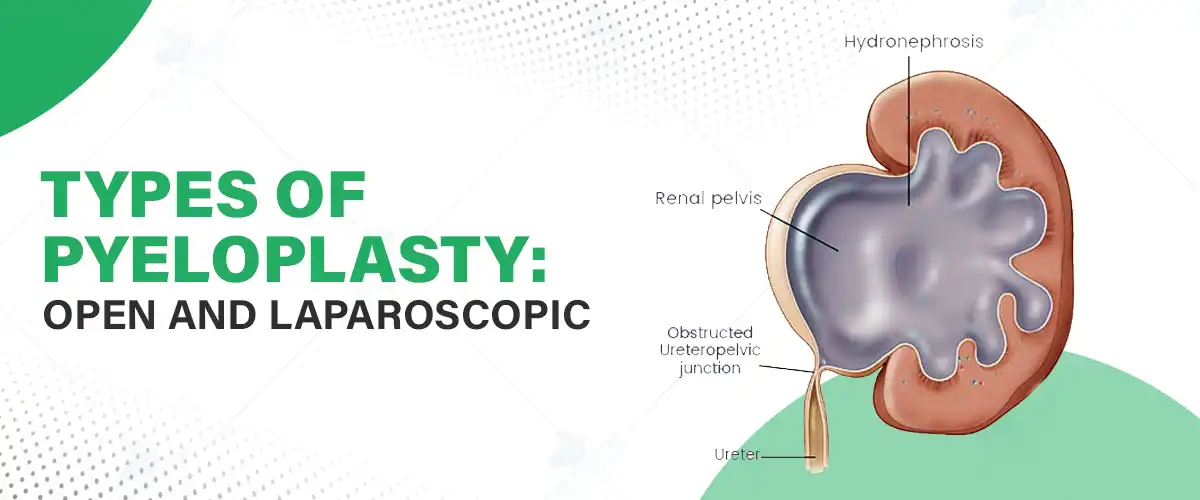
Subscribe to our

Pyeloplasty is a surgical procedure performed to correct ureteropelvic junction (UPJ) obstruction, a condition where the connection between the kidney and ureter is blocked, leading to urine retention and potential kidney damage. Treating UPJ obstruction is crucial to prevent complications such as kidney stones, infections, and reduced kidney function. If left untreated, it can cause severe pain and long-term damage. At the Top Pyeloplasty Hospital in Noida, expert urologists offer advanced treatment options to restore normal urine flow. There are two primary types of pyeloplasty: Open Pyeloplasty and Laparoscopic Pyeloplasty.
If you're experiencing symptoms of UPJ obstruction, don't wait. Book an appointment with the best urologists. Contact us today at +91 9667064100.
Pyeloplasty is a surgical procedure aimed at removing or reconstructing a blocked segment of the ureter to ensure smooth urine drainage from the kidney to the bladder. This procedure is commonly performed in both children and adults experiencing UPJ obstruction.
UPJ obstruction can occur due to various reasons, including:
Symptoms Indicating the Need for Pyeloplasty
Procedure:
Open pyeloplasty involves making a large incision in the flank region to access the affected ureter and kidney. The obstructed segment is removed, and the ureter is reattached to ensure proper drainage.
Advantages:
Disadvantages:
Procedure:
Laparoscopic pyeloplasty is a minimally invasive surgical approach that uses small incisions and a camera-assisted technique. The laparoscopic pyeloplasty steps involve:
Advantages:
Disadvantages:
Feature | Open Pyeloplasty | Laparoscopic Pyeloplasty |
Incision Size | Large | Small (keyhole incisions) |
Recovery Time | Longer | Faster |
Hospital Stay | 4-7 days | 1-3 Days |
Pain & Scarring | More | Less |
Suitability | Complex cases | Most cases |
Benefits of pyeloplasty include:
As with any surgery, pyeloplasty comes with risks. These include:
It can take a week or two to recover from a pyeloplasty. You might have pain when you pee or blood in your pee for about a week or until your provider removes the stent. You can usually return to your typical activities three to four weeks after the procedure.
You’ll have follow-up appointments with your provider to:
While you recover, you might want to have a caregiver to help you at least some of the time. Your provider will give you instructions on how to best take care of yourself. They might recommend:
Choosing the right type of pyeloplasty depends on several factors, including the severity of the obstruction, the patient’s age, overall health, and the expertise of the surgeon. At Felix Hospital, you can consult with Dr. Bhanwar Lal Barkesiya, a renowned urologist specializing in pyeloplasty procedures. The Best Pyeloplasty Doctors in Noida ensure personalized treatment plans based on individual patient needs.
Experience the benefits of advanced pyeloplasty techniques with our specialized urology team. Click Here for more information.
Both open and laparoscopic pyeloplasty are effective surgical techniques for treating UPJ obstruction. While open surgery is recommended for complex cases, laparoscopic pyeloplasty steps make it a preferred choice for most patients due to its minimally invasive nature and faster recovery. If you or your loved one is experiencing symptoms of UPJ obstruction, it is essential to seek medical attention promptly. The laparoscopic pyeloplasty surgery cost in Noida varies depending on hospital facilities and the complexity of the case. Consult a specialist at Felix Hospital to discuss the best treatment option and ensure a smooth recovery.
Q- What are the signs that indicate I need pyeloplasty?
Ans- Persistent flank pain, recurrent kidney infections, and difficulty urinating are common symptoms that may indicate UPJ obstruction, which may require pyeloplasty. Blood in the urine or nausea due to kidney swelling are also warning signs. It's important to consult with a specialist for an accurate diagnosis.
Q- Is laparoscopic pyeloplasty suitable for children?
Ans- Yes, laparoscopic pyeloplasty is often recommended for children, especially in cases of congenital UPJ obstruction. However, the suitability of laparoscopic vs. open surgery depends on the child’s age, size, and the complexity of the obstruction.
Q- Can open pyeloplasty be done in patients with a history of prior abdominal surgery?
Ans- Yes, open pyeloplasty can still be performed in patients who have had previous abdominal surgeries. However, the presence of scar tissue may make the procedure more complex, and a detailed assessment by the surgeon is required to determine the best approach.
Q- What is the recovery time for laparoscopic pyeloplasty compared to open pyeloplasty?
Ans- Laparoscopic pyeloplasty typically offers a faster recovery time, with most patients being able to return to regular activities within 3-4 weeks. In contrast, open pyeloplasty requires a longer recovery period, often taking 4-6 weeks for full recovery.
Q- Can pyeloplasty fix kidney damage caused by UPJ obstruction?
Ans- Pyeloplasty can restore proper urine flow, which prevents further kidney damage and improves kidney function. However, if significant damage has already occurred, such as loss of kidney function, the surgery may help prevent further deterioration but cannot fully reverse pre-existing damage.
Q- What are the chances of UPJ obstruction recurring after pyeloplasty?
Ans- Recurrence of UPJ obstruction after pyeloplasty is rare but can occur, particularly in patients with severe scarring or complex cases. Your surgeon will provide follow-up care and monitor kidney function to detect any issues early.
Q- How is the stent managed post-surgery, and why is it necessary?
Ans- After pyeloplasty, a stent is placed temporarily to ensure proper urine drainage during healing. The stent is typically removed after 1-2 weeks through a simple procedure. If left in too long, it may cause discomfort or infection, so follow-up care is essential.